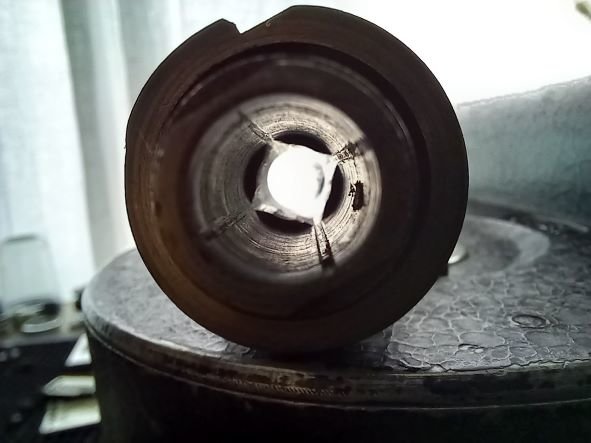-
Posts
2,423 -
Joined
-
Last visited
Everything posted by Simon Wyss
-

70HR/KRM info, instruction manual, tips
Simon Wyss replied to Philip Forrest's topic in Bell + Howell
The film seems to be pulled from the upper feed roller. See that everything turns freely on the magazine feed side, especially the film roll itself. Perhaps the sprocket guide fits too loosely also. -

70HR/KRM info, instruction manual, tips
Simon Wyss replied to Philip Forrest's topic in Bell + Howell
Transport failure, camera needs investigation by a technician. -
Why not shoot video and film out eventually? Nice spliceless prints can be had that way for crisp projections.
-

70HR/KRM info, instruction manual, tips
Simon Wyss replied to Philip Forrest's topic in Bell + Howell
Only if overstretched. Basically, these are simply long pull springs, the ends hooked (better close-bent) together. Mostly made of patented wire (drawn fast and air-hardened). The proof is simple: relaxed the windings should be in touch, a closed coil. I am quite sure that some can still be found. Might be worthwhile to call Magna-Tech of Miami. https://magna-tech.com/ -

70HR/KRM info, instruction manual, tips
Simon Wyss replied to Philip Forrest's topic in Bell + Howell
I think you’ll have more luck finding Filmo 70 magazine spring belts than me in Europe. At total failure a spring factory can make you those. -
Cinema Products
-
Should very much like to help you with it. Have a look at my website, if you please, to be found with my profile.
-
You’re not ADD, you’re DDT.
-

NEW ORWO STOCK - TEST RESULTS
Simon Wyss replied to Ludwig Hagelstein's topic in Film Stocks & Processing
What pride jumps off that label! -

Camera Adjustment necessary when switching from 35mm Color to BW?
Simon Wyss replied to Alexander Boyd's topic in 35mm
It’s Abel Cine, isn’t it? The difference between jams and none may be that negative stocks are perforated short pitch and reversal films full pitch. An LTR claw pushes onto the hole edge at a very narrow angle. With long or full pitch stock you would have to adjust the claw stroke length which is not possible. -

Camera Adjustment necessary when switching from 35mm Color to BW?
Simon Wyss replied to Alexander Boyd's topic in 35mm
No adjustment necessary. -
Yeah, the tension. Mind you, that motor was made for 220 Volt, yet we have 230 Volt. Just of late I had someone here with an Arriflex 16 SR II and an old, half-melted charger. It gets dangerously hot. Why have you fallen for the WEBO M?
-
Just for clarity, you mean a Pathé WEBO M, don’t you? There are various electric motors, the torche ones, a big one made in Germany, others from France. -What watch? -Ten watch. -Such much?
-
It’s comparing an apple with a coconut. The one is normal focal length, the other a moderate wide-angle lens. The Elmarit has the old Tessar as its base, the 35 mm R just got an afocal group added frontally. The Summicron was designed after glass of higher refractive index has become available, n = 1,7000, and it is a slightly asymmetrical double-Gauss six-elements lens. If you wish to read yourself in technically, have a look at the publications of Prof. Cavina. The criteria you are listing can be respected with an 1893 Cooke portrait triplet. Creaminess is bullshit to me. Work with light, the lens just depicts what’s there.
-

Double8 camex reflex test Fomapan R100
Simon Wyss replied to Aapo Lettinen's topic in Film Stocks & Processing
Thanks for sharing Typical Camex overexposure of the first frames of every shot which comes from the heavy governor. Hence also a relatively low max. speed of 32 fps. Some years ago I published an article on that camera (in German). -

Camera repair in Europe and VAT (Pathe camera repair in Italy)
Simon Wyss replied to Mark Eastman's topic in 16mm
What value did you note on the customs slip? -

Looking for shutter angle data for 16mm cameras
Simon Wyss replied to Mike Owens's topic in Camera Operating & Gear
Michael Tisdale does great work but the data aren’t waterproof. Paillard & Cie already have given wrong numbers. The H-16 S for example has a 170-degrees shutter opening. The instructions to the H-16 Reflex speak of 17,526 mm flange focal distance, also besides the fact. -

Looking for shutter angle data for 16mm cameras
Simon Wyss replied to Mike Owens's topic in Camera Operating & Gear
With the Paillard-Bolex H-16 it depends on the model; angles vary between the early 190 and 144 degrees (M); same with Paillard-Bolex H-8, whether early, Standard or Reflex; Keystone A-9 has 160 degrees; Revere 16/26 have 133 degrees; Ciné-Kodak E has 165 degrees. -
Theater owners needed to invest also in special non-magnetic sprocket rollers for the projectors, aperture masks, sound readers for the COMMAG prints, pre-amplifiers and amplifiers, a curved wide screen, if it were to be done correctly, loudspeakers behind the new screen plus in the auditorium. With regard to the image aspect ratio, its presentation, and sound reproduction CinemaScope has suffered more than any other wide-screen system. VistaVision Motion Picture High Fidelity was too complicated for a gain that got zeroed by the improvement of film stocks.
-
Clipper oil is too thin. A common sewing machine oil is higher viscous. You can also pick a little bottle of bicycle oil somewhere. It should read free from acids and resins.




